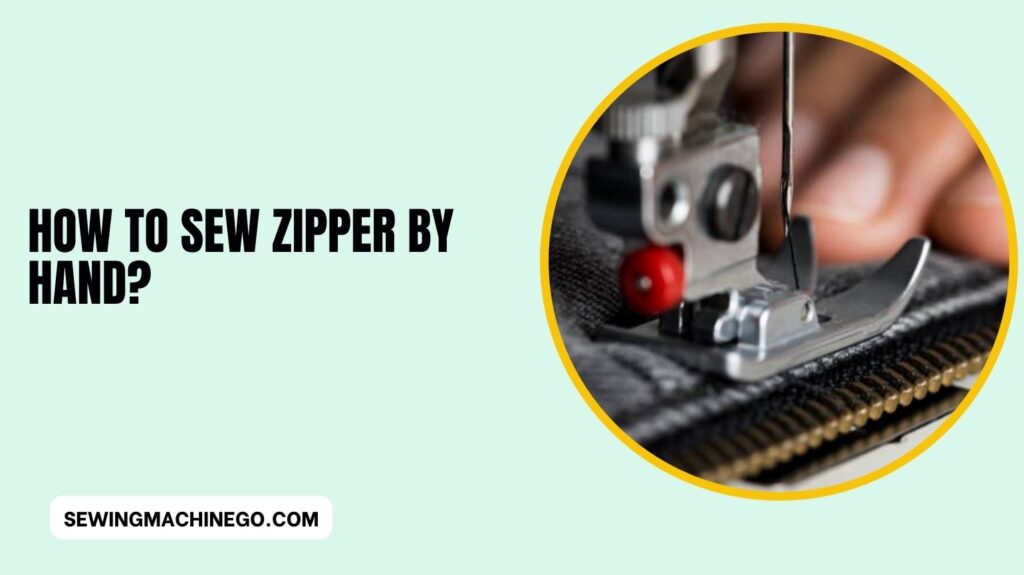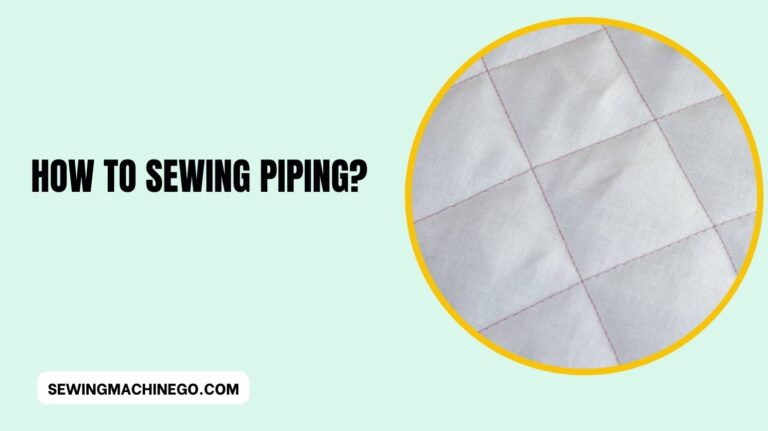How to Sew Zipper By Hand? Step By Steps Guide In 2024
In the world of sewing, mastering the art of hand-sewing zippers can elevate your craftsmanship to a new level. How to Sew Zipper By Hand?
Despite the availability of sewing machines, hand-sewing zippers remain a valuable skill for every tailor or crafting enthusiast.
Not only does it offer a deeper understanding of garment construction, but it also provides a sense of accomplishment and precision in your work.

Introduction to Hand-Sewing Zippers
When it comes to adding zippers to clothing or other fabric-based projects, hand-sewing offers a level of control and finesse that machines sometimes lack.
This skill allows you to create flawless closures and intricate designs that may be challenging to achieve using a sewing machine alone.
Preparing for Hand-Sewing Zippers
Before diving into the process, ensure you have the necessary materials handy.
Gather your fabric, the appropriate zipper, needles, thread, pins, and scissors. Setting up a clean and well-lit workspace will make the hand-sewing process more efficient and enjoyable.
Understanding the Zipper and Fabric
Different types of zippers serve various purposes. Understanding these variations and pairing them with the right fabric is crucial for successful hand-sewing.
Lightweight fabrics may require delicate zippers, while heavy-duty materials demand sturdier closures.
Step-by-Step Guide for Hand-Sewing Zippers
Here is the Step-by-Step Guide for Hand-Sewing Zippers:
- Preparing the Fabric and Zipper: Ensure both the fabric edges and zipper tape are clean and free from fraying.
- Positioning the Zipper Correctly: Pin the zipper in place, ensuring alignment with the fabric edges.
- Hand-Stitching Techniques: Use a needle and thread to make even and secure stitches along the zipper tape and fabric.
- Securing the Ends: Finish by securing the ends of the zipper to prevent unraveling.
Tips for Perfect Hand-Sewn Zippers
Consistency in your stitches is key. Maintaining an even tension and practicing patience will yield professional-looking results.
Additionally, troubleshooting common issues like puckering or misalignment can be easily rectified with practice and attention to detail. Perfecting hand-sewn zippers requires attention to detail and patience.
Here are some tips to achieve flawless results:
- Preparation is Key: Ensure your fabric edges are clean and neatly trimmed. A well-prepared fabric surface is crucial for smooth stitching.
- Use Quality Materials: Invest in good-quality zippers, threads, and needles. The right tools can make a significant difference in the final outcome.
- Pin and Baste: Secure the zipper in place with pins before stitching. Basting the zipper in position helps maintain alignment and prevents slippage.
- Practice Consistent Stitches: Maintain even tension in your stitches. Consistency in stitch length and spacing creates a professional look and ensures the zipper functions smoothly.
- Start and End Securely: Begin and finish your stitches with secure knots or backstitches. This prevents unraveling and reinforces the integrity of your work.
- Test and Adjust: Before completing the sewing, test the zipper to ensure smooth movement. Make any necessary adjustments before finalizing the stitching.
- Patience Pays Off: Take your time and avoid rushing through the process. Precision and patience are key to achieving neat and polished results.
- Learn from Mistakes: Don’t be discouraged by mistakes. Each attempt is an opportunity to learn and improve your technique. Analyze errors and adjust accordingly for the next project.
- Finishing Touches: Once the zipper is securely attached, press the fabric carefully to flatten any wrinkles or creases around the zipper area.
- Practice Regularly: Like any skill, practice makes perfect. Regularly practicing hand-sewn zippers will enhance your proficiency and confidence in this technique.
Advantages of Hand-Sewing Zippers
The precision and control offered by hand-sewing zippers allow for a more personalized touch to your creations.
Perfectly executed hand-sewn zippers can become a hallmark of your craftsmanship, setting your work apart and adding value to your garments.
Hand-sewing zippers, through a meticulous process, offer several advantages that elevate the quality and craftsmanship of your work:
- Precision and Control: Hand-sewing allows for precise control over the placement and alignment of the zipper. This level of precision ensures a tailored and custom fit, especially in intricate garment designs.
- Personalized Touch: Hand-sewn zippers add a unique, personalized touch to your creations. The careful handiwork imparts a sense of craftsmanship and individuality, distinguishing your work from mass-produced items.
- Versatility in Fabric Choice: Hand-sewn zippers accommodate various fabric types. Whether it’s delicate silk or sturdy denim, the flexibility of hand-sewing allows for seamless integration with different materials.
- Attention to Detail: The hand-sewing process allows you to focus on finer details, ensuring every stitch is consistent and flawless. This attention to detail contributes to a refined finish in your garments.
- Durability and Strength: When executed skillfully, hand-sewn zippers can be as durable as machine-sewn ones. Careful stitching and reinforcement at stress points enhance the zipper’s strength and longevity.
- Craftsmanship Mastery: Mastering the art of hand-sewing zippers reflects a high level of craftsmanship and expertise. It demonstrates dedication to quality and precision in garment construction.
- Repair and Customization: Hand-sewn zippers are easier to repair or replace than machine-sewn ones. Additionally, they allow for easy customization, enabling alterations without damaging the fabric or overall design.
- Artistic Expression: Hand-sewn zippers offer a canvas for artistic expression. They allow for creative stitching techniques, decorative elements, or unique placements, showcasing your creativity in garment construction.
- Portability and Convenience: Hand-sewing zippers don’t require access to a sewing machine, making it a portable and convenient technique for on-the-go sewing or small projects.
- Satisfaction and Pride: The satisfaction of creating a beautifully finished garment through meticulous hand-sewing instills a sense of pride and accomplishment, fostering a deeper connection to your creations.
Embracing hand-sewn zippers not only enhances the quality of your garments but also adds a touch of craftsmanship and artistry, making your creations stand out with unparalleled detail and finesse.
People also ask
How do you manually sew a zipper?
To manually sew a zipper:
Prepare the fabric: Place the zipper face-down on one fabric edge, aligning the teeth with the fabric edge. Pin it in place.
Use a zipper foot: Attach the zipper foot to your sewing machine.
Start sewing: Begin at the top of the zipper, close to the slider. Sew along one side, keeping the zipper teeth against the edge, using the zipper foot as a guide.
Stop and secure: When nearing the zipper’s end, stop, secure the stitch, and lift the foot. Close the zipper halfway to easily sew the other side.
Repeat for the other side: Repeat the process on the other side, ensuring the zipper aligns properly.
Test: After sewing both sides, check if the zipper opens and closes smoothly.
Can you attach a zipper without a sewing machine?
Yes, you can attach a zipper by hand without a sewing machine using a technique called hand sewing or hand stitching.
It involves using a needle and thread to sew the zipper onto the fabric manually.
While it might take more time and effort compared to using a machine, it’s entirely possible to attach a zipper by hand.
What stitch do you use to sew a zipper?
When sewing a zipper, the most commonly used stitch is the straight stitch.
Using a zipper foot on your sewing machine helps guide the fabric along the zipper teeth, creating a neat and secure seam close to the zipper.
How do you sew an invisible zip by hand?
Sewing an invisible zipper by hand involves a technique called a slip stitch. Here’s a brief overview:
Prepare the zipper: Pin the zipper face-down on the fabric, aligning the teeth with the seam allowance. Baste or use an invisible zipper foot to temporarily secure it.
Thread and needle: Use a matching thread and a hand-sewing needle. Knot the end of the thread.
Start at the bottom: Begin at the bottom of the zipper. Insert the needle into the fabric fold, catching a small amount of the zipper tape. Pull the thread through.
Slip stitch: Take small, even stitches along the edge of the fabric and the zipper tape, keeping them as invisible as possible. Make sure not to catch the outer fabric. Continue until you reach the zipper’s top.
Secure and finish: Knot the thread and secure it inside the fabric. Test the zipper to ensure smooth operation.
Practice and patience are key to achieving a seamless invisible zipper by hand.
Conclusion – How to Sew Zipper By Hand?
Mastering the art of sewing a zipper by hand is a valuable skill that adds finesse to your craftsmanship. With patience and practice, you can seamlessly integrate zippers into your projects.
Remember, the key lies in precise stitches, careful alignment, and a steady hand.
By following these steps and honing your technique, you’ll confidently conquer zipper sewing by hand, opening a world of creative possibilities in your sewing endeavors.

Hi, I am Alice, and I am your perfect guide to the world of sewing machines. With over 10 years of experience in the sewing industry, I am passionate about sharing my knowledge and expertise to help you make the most of your sewing journey. about me






